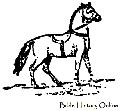
|
Horse With Saddle Pad And Girth
|
|
Ancient Romans regularly rode on stuffed padsaddles or pieces of cloth folded as to form a pad of comfortable thickness and was made secure by one or more girths. |
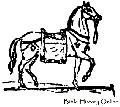
|
Horses Equipment
|
|
Horses equipment from Arch of Septimus. |
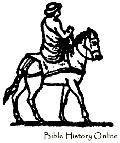
|
Riding Sideways
|
|
Many imperial medals from ancient Roman times represent women as riding sideways. A painting in Pompeii also showed men as riding in this fashion. |

|
Pack Horse
|
|
Illustration of a pack horse, from Triumphal Arch of Constantine. |
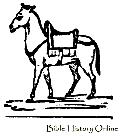
|
Pack Saddle
|
|
Ancient Romans often travel with a pack saddle of considerable size suitable for receiving the bundles placed upon it. This illustration of a pack saddle is from a painting at Herculaneum. |

|
Sumpter Horse
|
|
Illustration of a sumpter horse or a horse that carries baggage for travels. From Column of Trajan. |

|
Yoke For Horses
|
|
During the ancient Roman times, if only one or two horse or mule was used, it was placed in shafts but drew the vehicle by means of a yoke. This yoke was a plain wooden bow with an arc to fit the neck of the animal on which it rested. |

|
Arcera
|
|
The arcera is a vehicle often used among the ancient Romans. It had four wheels, a cover and was generally drawn by two or more horses. The outside consisted of unhewn boards covered by loose drapery. This vehicle was especially used to convey the sick and infirm and was of sufficient size to allow occupants to recline. |

|
Arcima
|
|
Illustration of an arcima from a sepulchral bas-relief. The arcima was a small conveyance that is large enough for only one person. |

|
Basterna
|
|
Illustration of a basterna from the imperial period. This vehicle was commonly used by women when travelling and was borne by two mules, one before and one behind each hitched to a separate pair of shafts. |

|
Benna
|
|
An illustration of a benna from the Column of Antoninus. This four wheeled conveyance is made of wicker work and was of Gallic origin. A benna can accommodate several persons when travelling. |

|
Carpentum
|
|
Illustration of a carpentum, a vehicle used by early Romans in as early as 500 B.C. and as late as fifth century of the Christian era. The carpentum was a covered carriage with two wheels, had seats for two or three and was usually drawn by two mules, horses or even oxen. |

|
Carruca
|
|
An illustration of a carruca. This vehicle had four wheels, with the front ones smaller than the two behind. This had a cover and was drawn by two to four horses or mules. The carriage was often ornamented by carvings in bronze and ivory and by chasings in silver and gold. Members of the imperial families were fond of travelling using this kind of coach. |

|
Carrus
|
|
The carrus was a cart with two wheels and boarded sides, it was drawn by oxen or bullocks and was mainly used by the Roman armies for the transportation of their baggage and supplies. |

|
Cisium
|
|
Illustration of a cisium, a light open vehicle of Gallic origin, had two wheels and room for two persons. It also has a box or case beneath the seat, where small baggage can be carried in. Two or three horses or mules were used to draw this and because of the lightness of this carriage this is especially suitable for rapid travels. |

|
Lectica
|
|
Illustration of a lectica, a kind of litter, sedan or palanquin of Oriental origin. The body was wooden with low sides and had upright pieces supporting a tester whose top was covered with leather. From the top curtains were suspended and these could be closed all around or drawn back. This vehicle was also provided with soft mattress, bolster and pillows so that the passenger can comfortably read, sit or write. Attached to this carriage are poles and by means of these it was carried on the shoulders of sedan bearers. |

|
Pilentum
|
|
Illustration of a supposed pilentum from a medal of the Empress Faustina. The pilentum was used chiefly by women of the upper classes. It was furnished with cushions, had a covered top, but open sides. Besides being a travelling vehicle, the pilentum was also used on state occasions by Roman matrons, priests and vestal virgins. In this they carried sacred vessels and rode in processions and public games. |

|
Two Wheeled Plaustrum
|
|
Illustration of a two-wheeled plaustrum. |

|
Small Plaustrum
|
|
Illustration of a small plaustrum. |
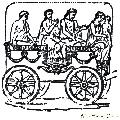
|
Raeda
|
|
Illustration of a raeda. The use of this carriage was common among the Romans during the last century of the republic. A commodious vehicle of Gallic origin and had four wheels, this was used by a man when he traveled with his family because this has sufficient room for several persons together with their luggage. |
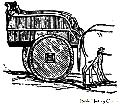
|
Supposed Sarracum
|
|
Illustration of a supposed sarracum. This was used by ancient Roman farmers as a traveling vehicle for themselves and their families. |
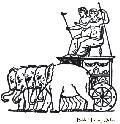
|
Tensa
|
|
The tensa was a sacred vehicle elaborately ornamented with ivory and silver. This had either two or four wheels and was drawn by four horses or as in this illustration by elephants. This carriage was used during Circensian games, to carry the images of deities. |

|
Clabularis
|
|
Illustration of a clabularis. |























